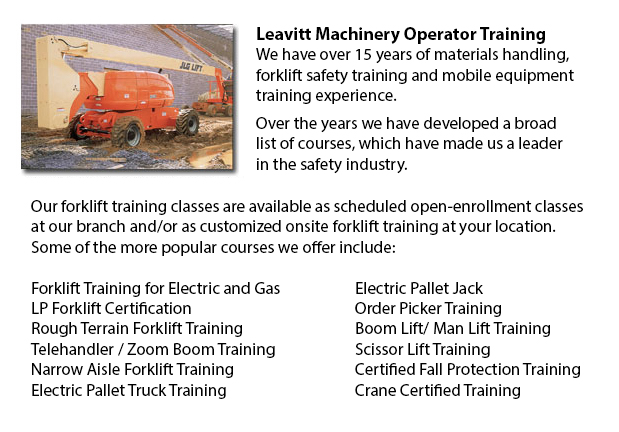
Barrie Boom Lift Certification - Elevated work platforms allow maintenance operations and work to be carried out at levels which could not be reached by any other way. Workers utilizing boom lifts and scissor lifts could be taught the safe operation of these machines by acquiring boom lift certification training.
Despite the variety in lift style, applications and site conditions, all lifts have the possibility for death or serious injury when not safely operated. Electrocution, falls, crushed body parts, and tip-overs could be the unfortunate outcome of improper operating procedures.
To prevent aerial lift incidents, people should be qualified to be able to train workers in operating the specific kind of aerial lift they will be using. Controls should be easily accessible in or beside the platform of boom lifts utilized for carrying workers. Aerial lifts should not be be modified without the express permission of other recognized entity or the manufacturer. If you are leasing a lift, ensure that it is correctly maintained. Before utilizing, controls and safety devices should be inspected in order to make sure they are properly functioning.
It is essential to follow safe operating procedures to be able to avoid workplace accidents. Driving an aerial lift while the lift is extended must not be done, nevertheless, some models are designed to be driven when the lift is extended. Always set brakes. Set outriggers, if available. Avoid slopes, but when necessary use wheel chocks on slopes that do not exceed the manufacturer's slope limits. Follow manufacturer's weight and load restrictions. When standing on the platform of boom lifts, use a safety belt with a two-foot lanyard tied to the basket or boom or a full-body harness. Fall protection is not needed for scissor lifts that have guardrails. Do not sit or climb on guardrails.
The boom lift certification course provides instruction in the following fields: training and certification; safety tips to be able to prevent a tip-over; inspecting the work area and travel path; slopes and surface conditions; stability factors; other tips for maintaining stability; weight capacity; leverage; testing control functions; pre-operational inspection; mounting a motor vehicle; safe operating practices; safe driving procedures; power lines and overhead obstacles; utilizing harness and lanyards; PPE and fall protection; and prevent falling from platforms.
When successful, the trained worker would be familiar with the following: pre-operational check procedures; authorization and training procedures; factors affecting the stability of scissor and boom lifts; how to prevent tip-overs; how to use the testing control functions; how to use PPE and fall prevention strategies.
-
Barrie Warehouse Forklift Safety Training
Barrie Warehouse Forklift Safety Training - Businesses normally face liability for injuries and damage sustained in workplace accidents. Warehouses can be hazardous places to the individuals who work there. That is the reason why employee safety is a... More -
Barrie Aerial Platform Training
Barrie Aerial Platform Training - Aerial lifts can accommodate many duties involving high and tricky reaching places. Normally used to carry out regular upkeep in buildings with high ceilings, prune tree branches, hoist heavy shelving units or mend p... More -
Barrie Forklift Ticket
Barrie Forklift Ticket - Pallet jacks and lift trucks are both intended for practically the same reason; to transfer goods from one location of your warehouse to another. This is basically where the comparison stops however. With the pallet jack, the... More -
Barrie Aerial Lift Training
Barrie Aerial Lift Training - An aerial work platform is a mechanized access platform. This machinery provides access to otherwise not accessible places for people or equipment. Also referred to as an aerial device or elevating work platform, the mac... More -
Barrie Aerial Boom Lift Training
Barrie Aerial Boom Lift Training - For people who operate or supervise the use of aerial lift platforms, correct aerial boom lift Training is required. The aerial lift platform is utilized for lifting individuals, tools and materials to elevated work... More -
Barrie Manlift Certification
Barrie Manlift Certification - The Elevated Platforms and Manlifts Certification program helps to provide the needed training on the work practices, safe operating procedures, rules and regulations regarding the everyday activities for the operators... More -
Barrie Overhead Crane Certification
Barrie Overhead Crane Certification - The overhead crane training certification course is designed to be effective with all participants regardless of literacy or language limitations. The course has two parts: a classroom training session and a prac... More -
Wheel and Track Loader Training in Barrie
Lift trucks are obtainable in several various units that have varying load capacities. The majority of typical lift trucks utilized in warehouse settings have load capacities of one to five tons. Bigger scale models are used for heavier loads, such a... More

Forklift Certification Barrie
TOLL FREE: 1-888-254-6157
Barrie, Ontario
forkliftcertificationbarrie.com
Email Us
About Us


